In today’s digital age, Artificial Intelligence (AI) is everywhere. From voice assistants on our phones to recommendation systems on streaming platforms, AI has seamlessly integrated into our daily lives.
But have you ever paused to think about the magic behind AI? How does it recognize a cat in a picture or predict the next song you’d love to hear? The answer lies in AI annotation tools.
Imagine teaching a toddler to identify objects. You’d probably show them a toy, say a car, and repeat, “This is a car.” Over time, with enough repetition, the child learns to recognize cars.
Similarly, for AI to recognize patterns, and objects, or make predictions, it needs data. But not just raw data; it requires labeled or ‘annotated’ data. This is where AI annotation tools come into play.
They help label vast amounts of data, making it understandable for AI models. But with a myriad of tools available in the market, choosing the right one can be overwhelming.
In this guide, we’ll demystify AI annotation tools, their significance, and how to pick the best one for your needs.
The Significance of AI Annotation
The world of AI is vast and ever-evolving. From detecting tumors in medical images to powering self-driving cars, AI’s applications are limitless. But the backbone of any successful AI model is data.
Think of AI as a sponge, eager to soak up knowledge. The data it consumes is its water. But what if this water is muddy or chaotic? The sponge can’t soak it up effectively. This is where AI annotation shines.
Annotation cleans and structures this data. It’s like clarifying muddy water. For instance, in a dataset of images containing cats and dogs, annotation helps label each image, indicating whether it’s a cat or a dog. This labeled data is then fed into AI models, helping them learn and differentiate between cats and dogs.
Without annotation, AI models are like students studying without textbooks. They have no reference, no guidance. AI annotation tools, therefore, play a pivotal role in the success of AI models, ensuring they have a clear, labeled dataset to learn from.
Criteria for Evaluating AI Annotation Tools
The digital marketplace is flooded with AI annotation tools, each boasting unique features. But how do you sift through the noise and choose the one that aligns with your needs? Here are some pivotal criteria to consider:
- Supported Formats: Just as a carpenter needs different tools for different tasks, your annotation tool should support various data formats, be it images, videos, or texts.
- Ease of Use: A tool, no matter how advanced, is futile if it’s not user-friendly. An intuitive interface ensures you spend less time grappling with functionalities and more time on actual annotation.
- Customization: Every project is unique. Your annotation tool should be flexible, allowing you to tailor it according to your project’s requirements.
- Cost: Budget constraints are real. While some tools offer advanced features at a premium price, others provide basic functionalities for free. Assess your needs and choose accordingly.
Top 12 AI Annotation Tools
1. V7
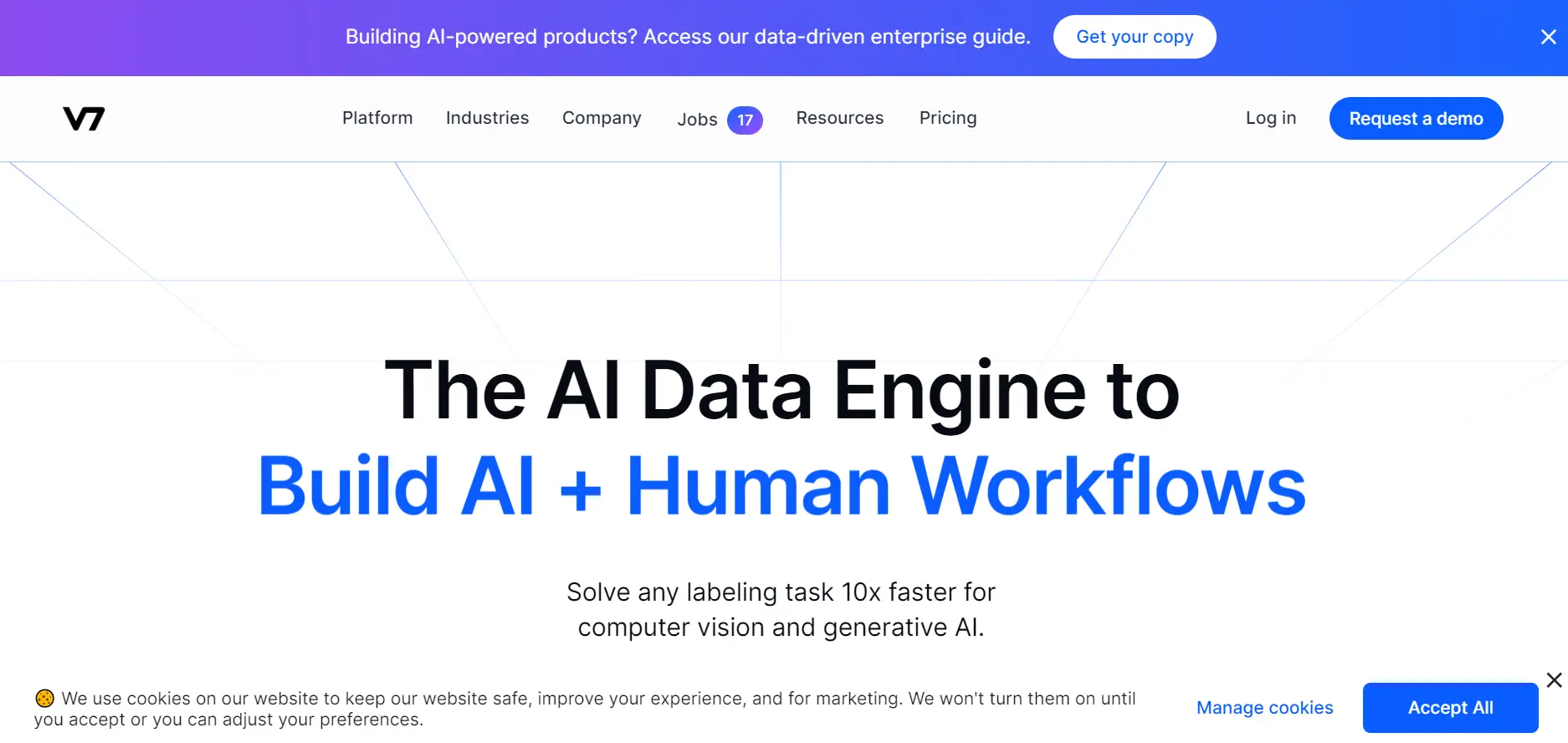
Ever clicked a photo and wondered how apps know what’s in it? That’s the magic of AI annotation tools like V7. V7 isn’t just any tool; it’s like having a smart friend by your side.
Imagine having thousands of photos, and you’re trying to find all the ones with cats. Sounds tiring, right? But with V7, it’s a breeze.
Now, let’s dive a bit deeper. V7 is known for its accuracy. It’s like that student in class who always gets the answers right. You show it a picture, and it can tell you what’s in it.
Cats, dogs, cars, trees – you name it. It’s like having a speed-reading friend who can go through a book in minutes. But what makes V7 stand out among other AI annotation tools?
It’s its user-friendly design. Using V7 feels like playing a game on your phone. It’s intuitive, simple, and fun. You don’t need to be a tech expert to use it. And if you ever get stuck, there’s always help around the corner.
Another cool thing about V7 is how it learns. It’s not static. The more you use it, the better it gets. It’s like teaching a child. At first, they might not get everything right.
But with time and practice, they become experts. V7 works the same way. It learns from its mistakes and gets smarter with each use.
Now, let’s talk about teamwork. If you’re working in a team, V7 has got you covered. It allows multiple people to work on the same project. It’s like having a group study session. Everyone can pitch in, share their insights, and make the project better.
In the world of AI annotation tools, V7 is a game-changer. It’s fast, accurate, user-friendly, and always learning. Whether you’re a professional or just someone looking to sort out their photos, V7 is the tool to go for.
2. Labelbox
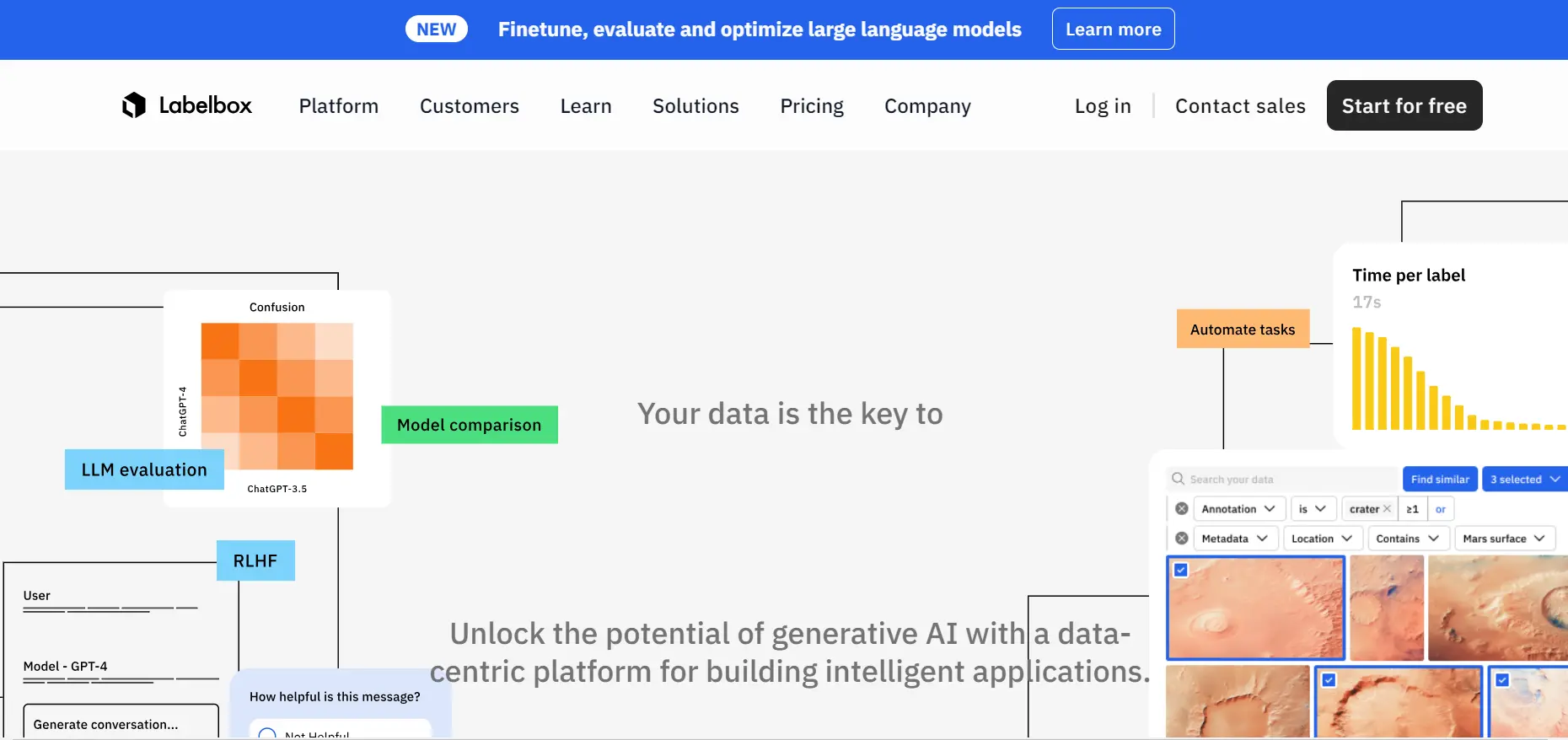
Labelbox is another gem in the world of AI annotation tools. Think of it as a Swiss army knife. It’s versatile, reliable, and always ready to help. Whether you’re dealing with images, videos, or text, Labelbox has got your back.
So, what’s the buzz about Labelbox? First off, it’s super easy to use. Imagine having a tool that feels like an extension of your hand. You think, and it does. That’s Labelbox for you.
It’s designed keeping you in mind. The interface is clean, the buttons are where you expect them to be, and there’s no jargon. It’s plain, simple English.
But don’t let its simplicity fool you. Under the hood, Labelbox is a powerhouse. It’s packed with features that make annotation a walk in the park.
Remember the times when you had to go through data line by line? With Labelbox, those days are gone. It’s like having a super-fast conveyor belt. Data comes, gets annotated, and moves on all in the blink of an eye.
One of the standout features of Labelbox among AI annotation tools is its collaboration capabilities. Working in a team? No problem. Labelbox is like a virtual meeting room.
Everyone can join in, share their views, and work together. It ensures that everyone is on the same page, making projects run smoothly.
Another feather in Labelbox’s cap is its adaptability. It’s not rigid. It understands that every project is unique. So, it allows you to customize it as per your needs. It’s like having a tailor-made suit. It fits just right.
In the ever-evolving landscape of AI annotation tools, Labelbox has carved a niche for itself. It’s not just a tool; it’s a partner. It’s there with you at every step, making sure your AI models are trained with the best data possible.
3. Keylabs
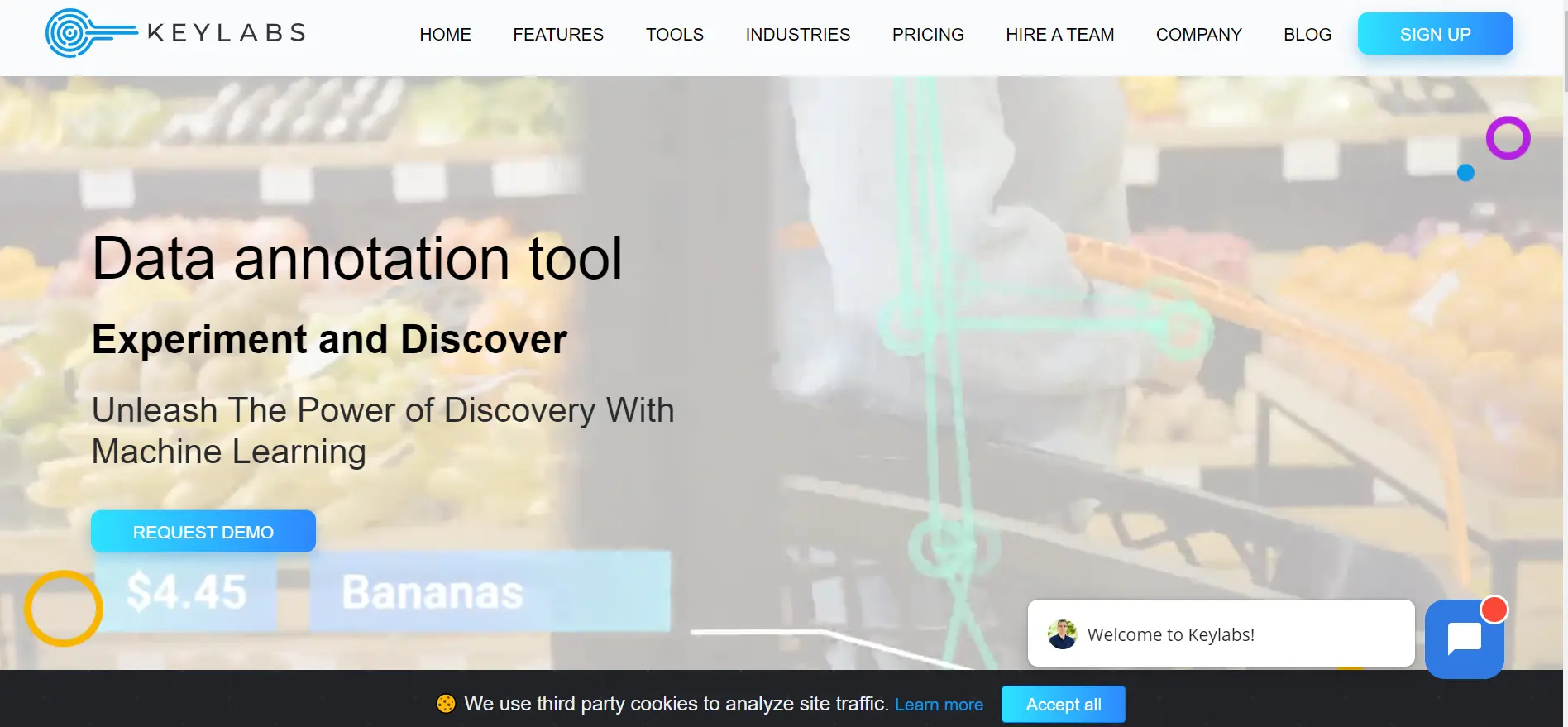
In the bustling city of AI annotation tools, Keylabs is like that trendy cafe everyone’s talking about. It’s modern, efficient, and always delivers.
If you’ve ever felt lost in the sea of data, Keylabs is your lighthouse. It guides, organizes, and makes sense of all that information.
Now, let’s get to know Keylabs a bit better. At its core, Keylabs is all about simplicity. Remember those old toys we had as kids? No fancy buttons, no confusing manuals, just pure fun. Keylabs brings back that simplicity.
It’s designed for everyone, from tech wizards to complete beginners. Using Keylabs feels like having a friendly chat. There’s no tech jargon, no complex procedures. It’s just you, your data, and a tool that understands you.
But don’t mistake its simplicity for lack of power. Keylabs is like a silent river, calm on the surface but strong underneath. It’s packed with features that make data annotation a breeze.
Imagine having a magic wand that sorts, labels, and organizes data with a flick. That’s Keylabs for you. It’s fast, accurate, and always on point.
One of the standout features of Keylabs among AI annotation tools is its learning capability. It’s not just a tool; it’s a student. With every project, it learns, adapts, and gets better. It’s like planting a tree.
At first, it’s small and needs care. But with time, it grows, becomes strong, and gives back. Keylabs is that tree, always growing, always giving back.
Collaboration is another area where Keylabs shines. In today’s world, teamwork is key. Whether you’re sitting next door or across the globe, Keylabs brings everyone together. It’s like a virtual workspace.
Everyone can pitch in, share their insights, and make the project shine. It ensures that no voice goes unheard, making projects richer and more diverse.
But what truly sets Keylabs apart in the world of AI annotation tools is its commitment to the future. It’s not just about today; it’s about tomorrow.
Keylabs is always evolving, and always looking ahead. It’s like a wise old sage, always learning, always growing. With Keylabs, you’re not just getting a tool; you’re getting a vision, a promise of a better future.
4. Scale AI
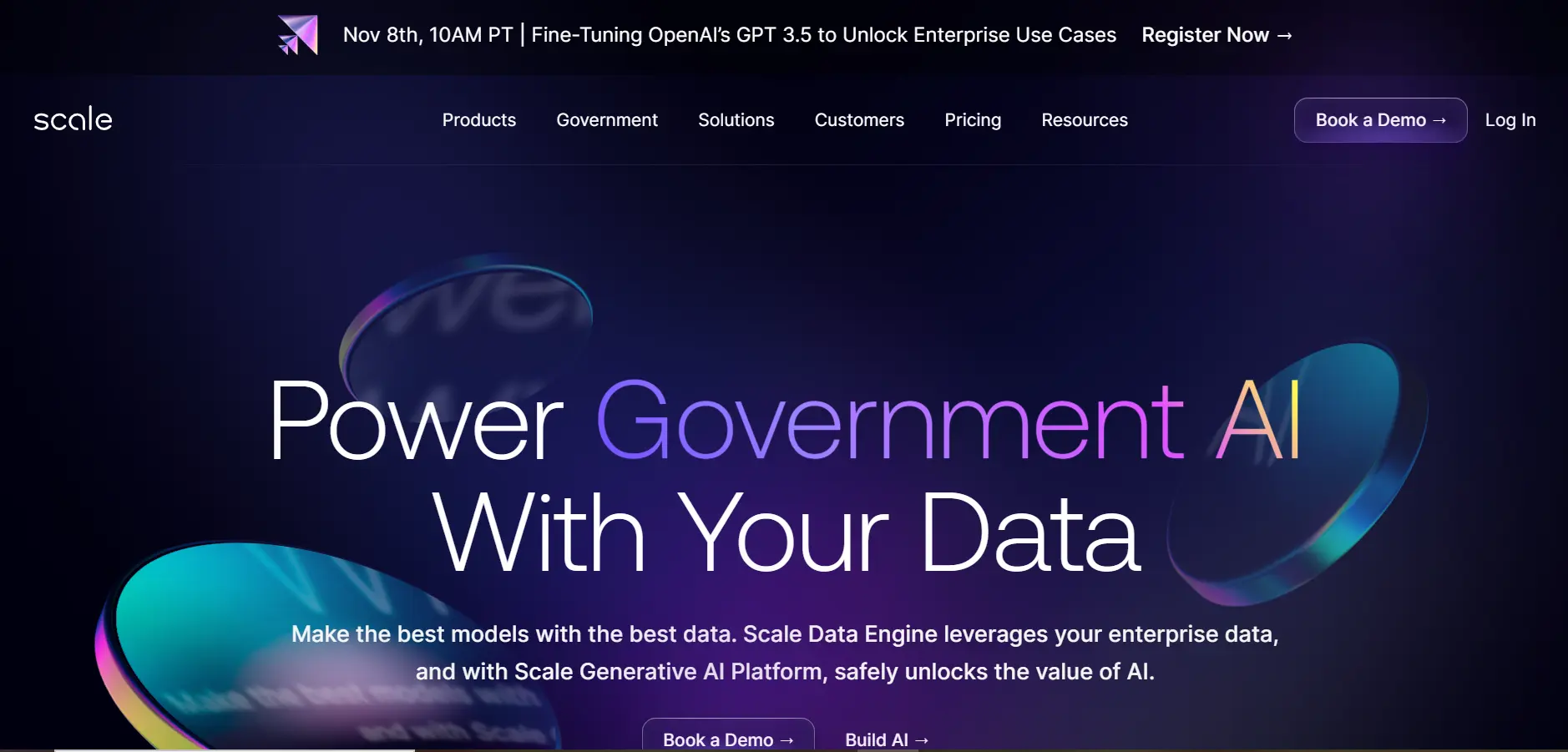
In the colorful world of AI annotation tools, Scale AI is like that trusty paintbrush every artist swears by. It’s reliable, precise, and always delivers a masterpiece. If data is your canvas, then Scale AI is the tool to bring your vision to life.
Let’s start with the basics. What’s the first thing you notice about a tool? How it feels in your hand, right? Scale AI is designed with you in mind. It’s like that comfy pair of shoes that fit just right.
No pinching, no discomfort, just a smooth experience. Using Scale AI feels natural. It’s like chatting with a friend. You talk, it listens, and together you create magic.
But what truly sets Scale AI apart in the crowded market of AI annotation tools is its precision. It’s like a surgeon’s scalpel, sharp and accurate.
Whether you’re dealing with images, videos, or text, Scale AI ensures that every annotation is spot on. It’s like having a magnifying glass that zooms in on the tiniest details, ensuring nothing is missed.
Now, let’s talk speed. In today’s fast-paced world, time is of the essence. And Scale AI understands that. It’s like a sprinter, always on its toes, ready to dash.
With Scale AI, projects that took days can now be wrapped up in hours. It’s all about efficiency, ensuring you get more done in less time.
Collaboration is another feather in Scale AI’s cap. Remember those group projects in school? Everyone brought something unique to the table. Scale AI recreates that experience.
It’s like a virtual classroom where everyone can share, learn, and grow. Whether you’re a team of two or two hundred, Scale AI ensures everyone’s in sync.
But the true beauty of Scale AI lies in its adaptability. In the ever-changing landscape of AI annotation tools, being rigid is a no-go. And Scale AI gets that. It’s like clay, ready to be molded as per your needs.
Whether you’re working on a small project or a massive one, Scale AI adapts, ensuring you always have the right tools at your disposal.
5. CrowdAI
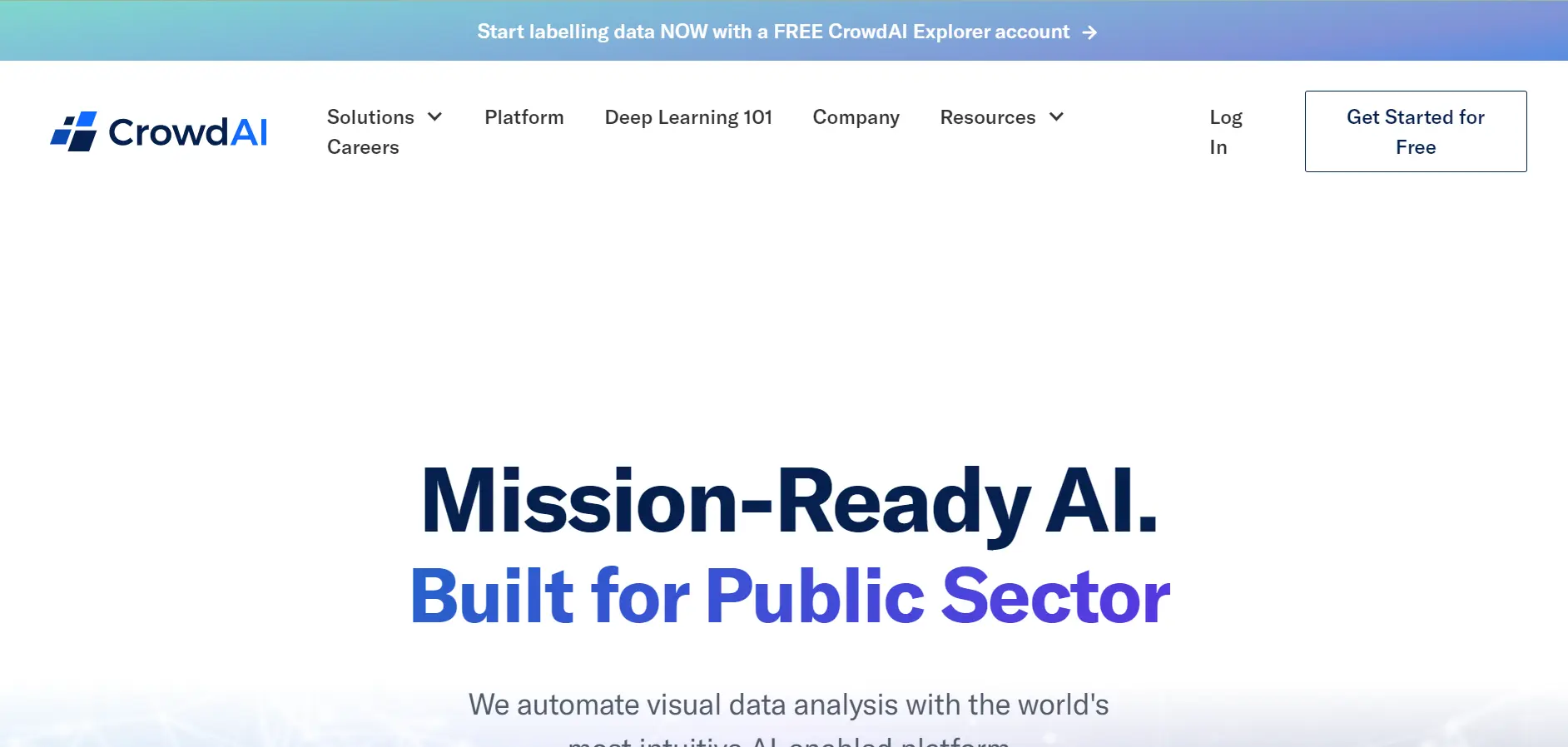
In the vast ocean of AI annotation tools, CrowdAI stands out like a lighthouse, guiding ships safely to the shore. It’s not just a tool; it’s a beacon of hope for those lost in the maze of data. If you’ve ever felt overwhelmed by the sheer volume of data, CrowdAI is here to help.
First things first, let’s talk about the name – CrowdAI. It’s not just a catchy title; it embodies the essence of the tool. It’s all about harnessing the power of the crowd. Imagine having a puzzle with a million pieces. Sounds daunting, right?
But what if you had a hundred friends helping you out? That’s CrowdAI for you. It brings together a community of experts, ensuring that data annotation is not just accurate but also swift.
Now, let’s talk about ease of use. Remember the joy of riding a bike for the first time, the wind in your hair, the world rushing by. Using CrowdAI feels just like that.
It’s exhilarating yet simple. There’s no steep learning curve, no jargon-filled manuals. It’s all plain English, making sure you feel at home.
But what truly sets CrowdAI apart in the bustling market of AI annotation tools is its collaborative spirit. It’s not just a tool; it’s a community.
It’s like a bustling marketplace where ideas are exchanged, knowledge is shared, and innovation thrives. Whether you’re a newbie or a seasoned pro, CrowdAI ensures your voice is heard.
Speed is another ace up CrowdAI’s sleeve. In the digital age, time waits for no one. And CrowdAI gets that. It’s like a race car, always in the top gear, ensuring projects are completed in record time. With CrowdAI, delays and extended timelines are a thing of the past.
But the real magic of CrowdAI lies in its adaptability. The world of AI is ever-evolving, and what’s relevant today might be obsolete tomorrow.
CrowdAI is always a step ahead. It’s like a chameleon, constantly adapting, ensuring you’re always equipped with the latest and the best.
6. SuperAnnotate
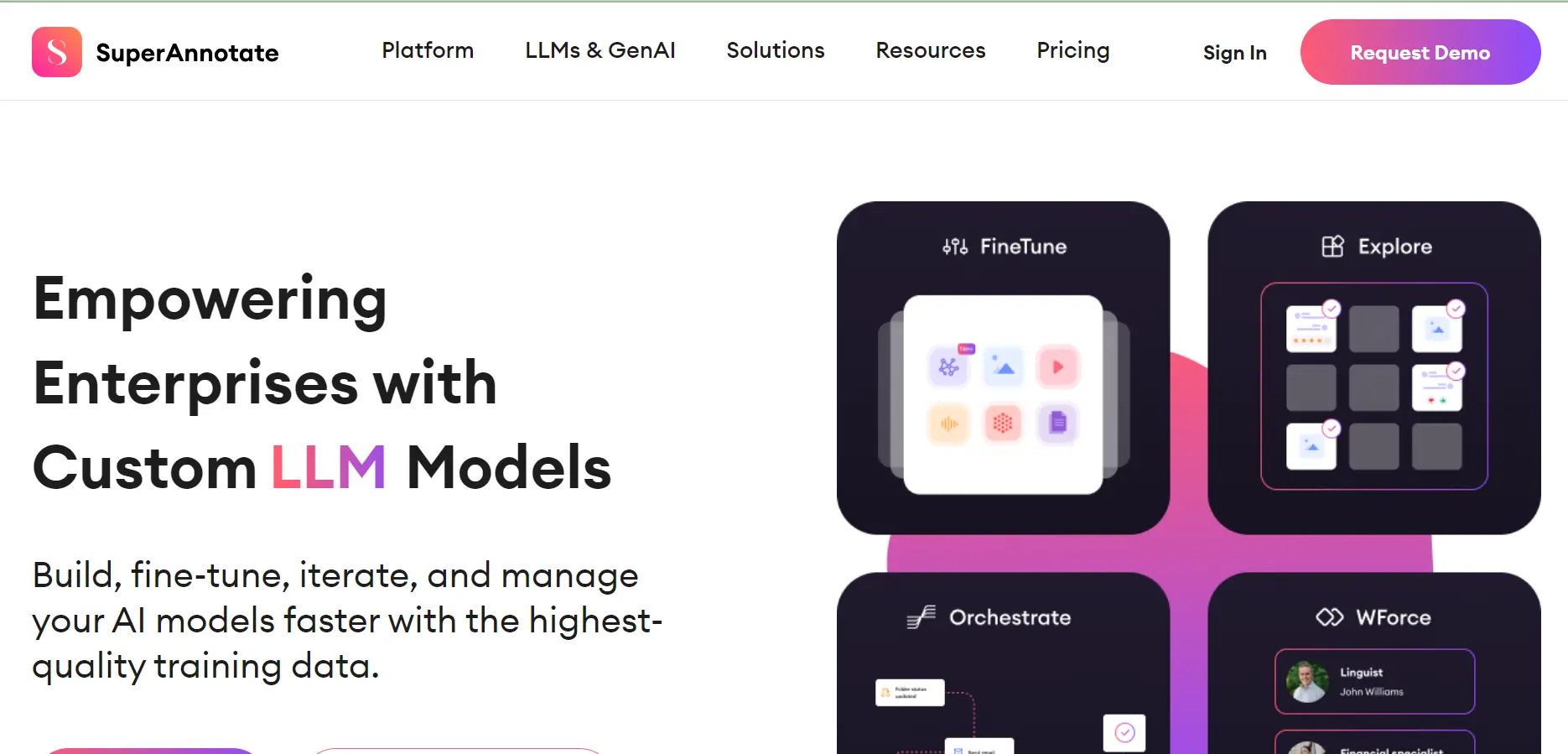
Imagine a toolbox. Now, not just any toolbox, but one that has every tool you could ever dream of. That’s SuperAnnotate for you in the world of AI annotation tools. It’s like a Swiss Army knife, ready to tackle any challenge you throw at it.
At its heart, SuperAnnotate is all about making your life easier. Remember those old board games with a hundred pieces and super tricky rules? And then there were those simple card games – easy to understand and loads of fun.
SuperAnnotate is like those card games. No fuss, no confusion, just straight-up results. It’s designed to be user-friendly. It’s like having a chat with an old friend. You ask, and SuperAnnotate delivers.
But what makes SuperAnnotate stand tall among other AI annotation tools? It’s its precision. Think of it as a master craftsman, paying attention to every tiny detail, ensuring nothing is missed.
Whether you’re working with images, videos, or any other form of data, SuperAnnotate ensures every pixel is perfect. It’s like having a magnifying glass that sees everything, leaving no room for errors.
Now, let’s talk about speed. In the fast-paced world of AI, every second counts. And SuperAnnotate knows that. It’s like a sprinter, always ready to dash, ensuring you reach the finish line in record time. With SuperAnnotate, long hours and endless waits are things of the past.
Collaboration is another area where SuperAnnotate shines bright. In today’s interconnected world, teamwork makes the dream work. And SuperAnnotate is all about that team spirit.
It’s like a virtual playground where everyone comes together, shares, learns and grows. Whether you’re a team of two or a big group, SuperAnnotate ensures everyone is in sync, making projects a breeze.
But the real beauty of SuperAnnotate lies in its adaptability. In the ever-changing landscape of AI annotation tools, being static is not an option and SuperAnnotate gets that.
It’s like water, taking the shape of whatever container you put it in. Whether you’re working on a small project or a massive one, SuperAnnotate adapts, ensuring you always have the best tools at your disposal.
7. Dataloop
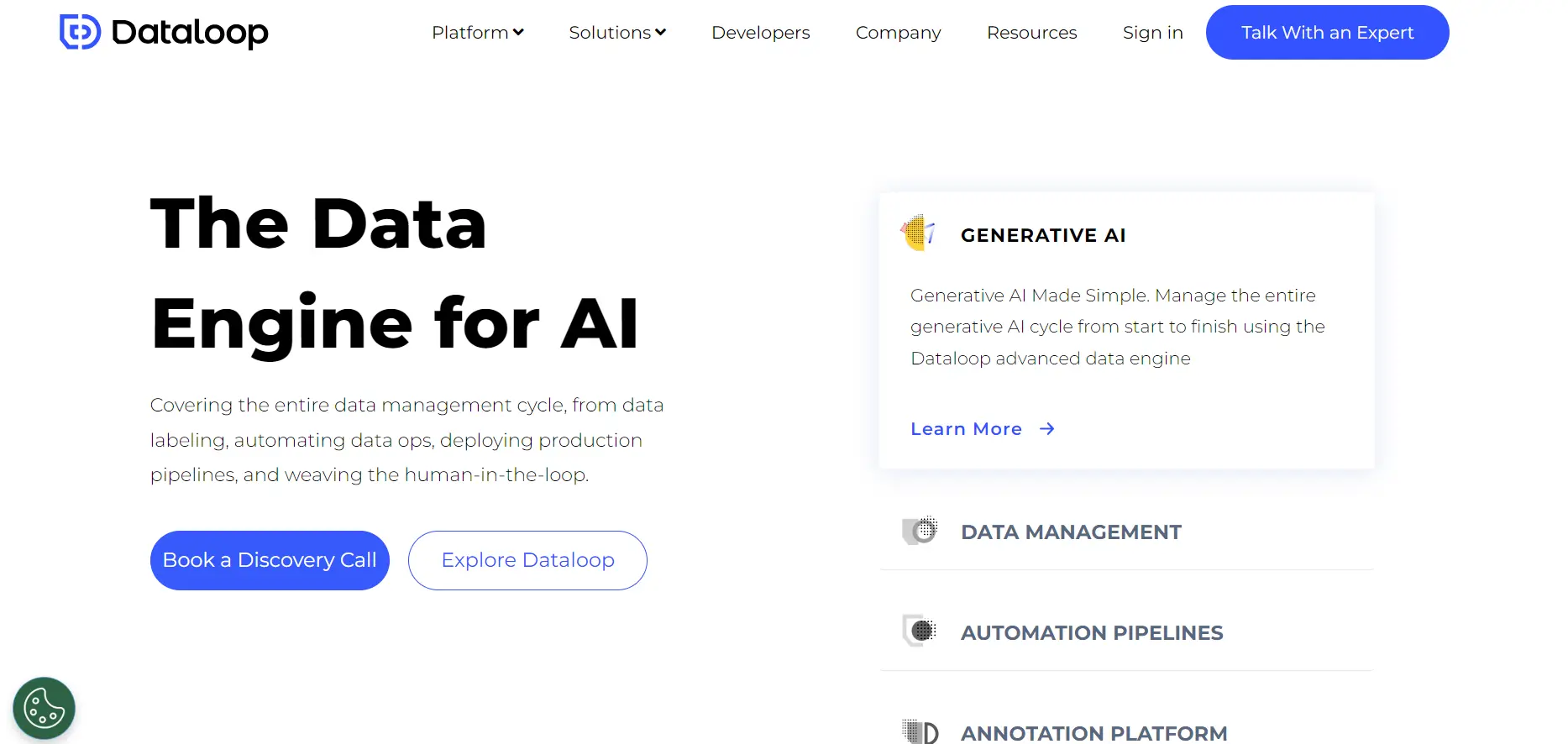
In the bustling world of AI annotation tools, Dataloop is like that quiet cafe corner where everything just works. It’s efficient, reliable, and always on point. If you’ve ever felt swamped with data, Dataloop is your go-to buddy, making things clear and organized.
So, what’s the buzz about Dataloop? First, it’s the ease of use. Remember those toys from childhood that needed no instructions? You just picked them up and played.
Dataloop feels just like that. It’s intuitive. No long manuals, no confusing terms. It’s all about getting things done, and with Dataloop, it’s a breeze.
But don’t let its simplicity fool you. Underneath, Dataloop is a powerhouse. In the realm of AI annotation tools, precision is key. And Dataloop nails it.
It’s like having a sharp-eyed friend who spots every tiny detail. You feed it data, and it gives back perfectly annotated results. No errors, no misses.
Now, let’s talk about teamwork. In today’s digital age, collaboration is the name of the game. And Dataloop is all in. It’s like a virtual workspace where everyone can chip in.
Whether you’re sitting next door or on another continent, Dataloop brings teams together. It’s all about sharing, learning, and growing together.
Another standout feature of Dataloop among AI annotation tools is its adaptability. The world of AI is vast and ever-changing. What works today might be outdated tomorrow.
Dataloop gets that. It’s always evolving, always adapting. It’s like a river, changing its course as needed, ensuring it always reaches the sea.
8. Supervisely
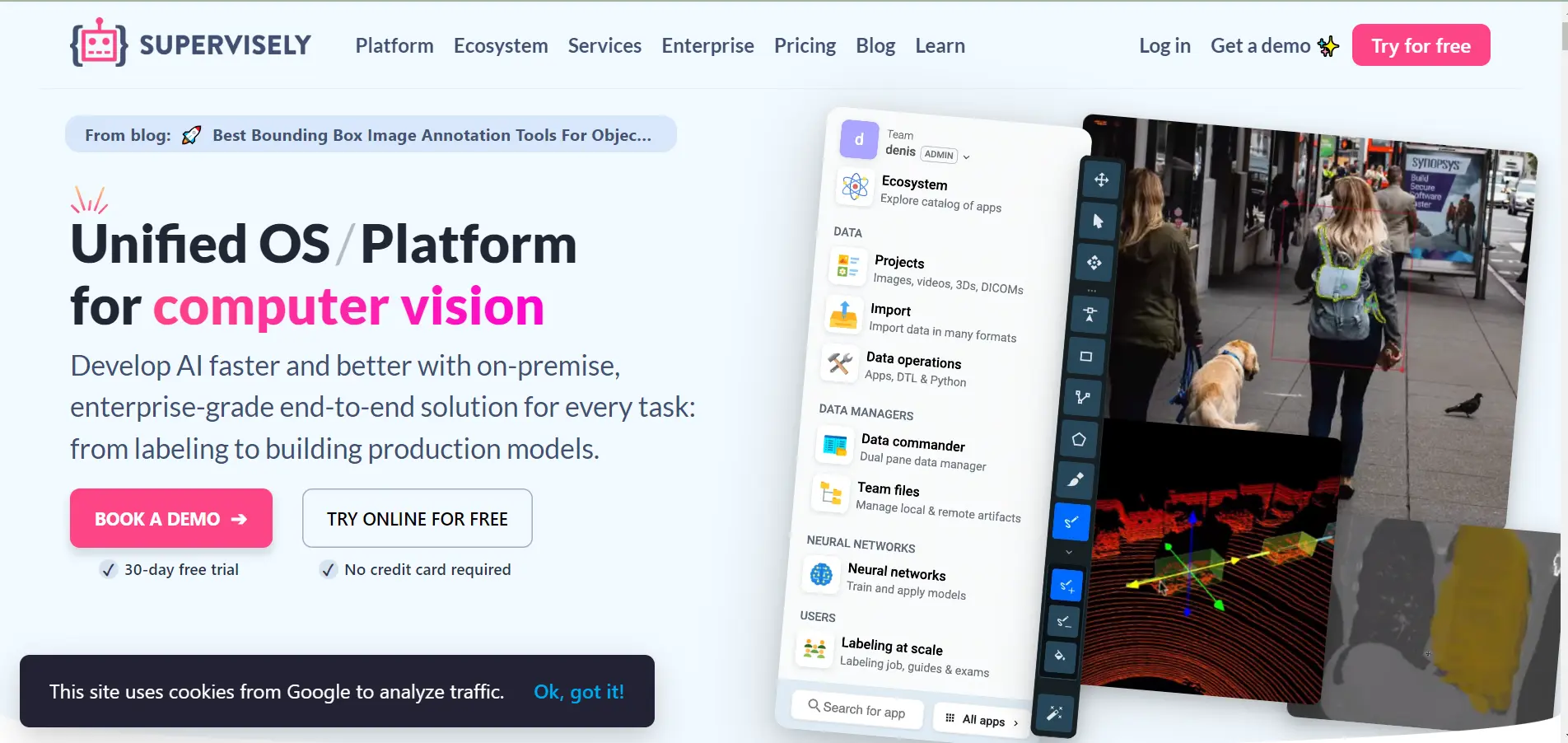
In the vibrant world of AI annotation tools, Supervisely is like that trusty compass always pointing you in the right direction. It’s a guide, a helper, and a game-changer.
If you’ve ever felt lost in the maze of data, Supervisely is the guiding light you’ve been searching for. So, what makes Supervisely special? Let’s start with its user-friendly nature.
Think back to those easy-to-use gadgets we all loved as kids. No fuss, just pure fun. Supervised brings that same feeling to the table. It’s straightforward and intuitive.
It’s like having a chat with a friend who always knows the answers. With Supervisely, there’s no jargon, just simple steps leading to great results.
But simplicity doesn’t mean it lacks power. Beneath its easy-going surface, Supervisely is a force to reckon with. Among AI annotation tools, accuracy is a big deal and Supervisely delivers.
It’s like having an eagle-eyed buddy who never misses a detail. You give it data, and it hands back perfectly labeled results. It’s all about precision and perfection.
Now, onto collaboration. In the digital age, teamwork is everything. And Supervisely embraces that spirit. It’s like a virtual clubhouse where everyone can join in.
No matter where you are, Supervisely bridges the gap. It’s a space for sharing, learning, and creating together. One of the standout features of Supervisely in the realm of AI annotation tools is its flexibility.
The AI world is always on the move, always evolving. And tools need to keep up. Supervised does just that. It’s like a tree, firmly rooted but always reaching for the sky. It adapts, grows, and ensures you’re always ahead of the curve.
9. Video Ant
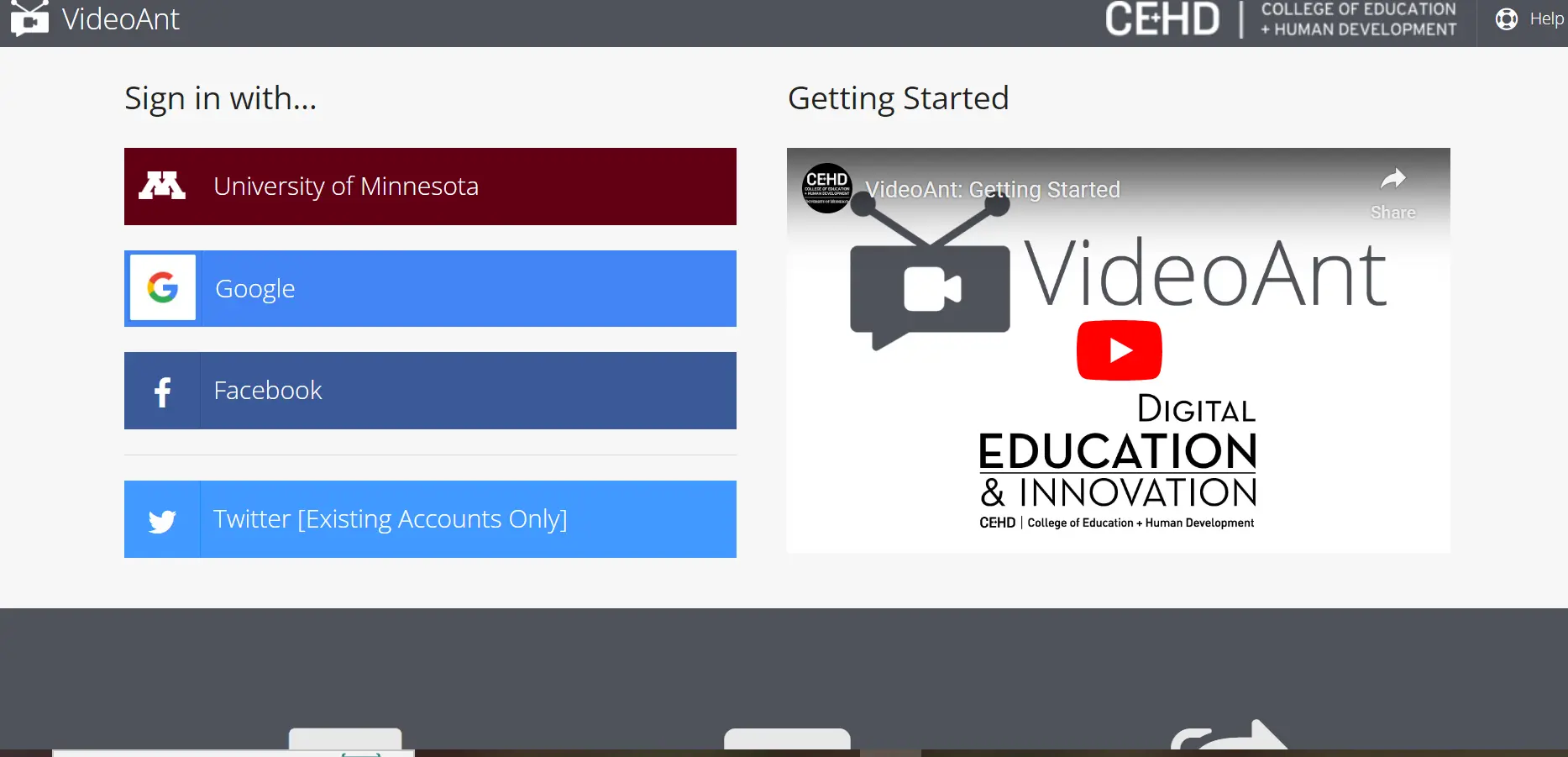
In the dynamic realm of AI annotation tools, Video Ant stands out like a colorful butterfly in a garden. It’s unique, efficient, and tailor-made for video enthusiasts.
If you’ve ever been intrigued by the world of videos and wondered how AI fits in, Video Ant is your answer. So, what’s the buzz about Video Ant? Well, as the name suggests, it’s all about videos.
Remember those times when you watched a video and wished you could label or comment on specific parts? Video Ant makes that dream come true. It’s like having a magic pen that lets you jot down notes directly on videos. Simple, right?
But Video Ant isn’t just about simplicity. Beneath its user-friendly exterior lies a robust engine. In the vast landscape of AI annotation tools, precision is the gold standard and Video Ant hits the bullseye.
It’s like having a sharp-eyed film director who notices every tiny detail. You play a video, and Video Ant ensures every frame is perfectly annotated.
Now, let’s talk collaboration. We live in a connected world, and teamwork is the heartbeat of any project. Video Ant embraces this spirit wholeheartedly.
It’s like a virtual movie theater where everyone can join, share their insights, and co-create. Whether you’re annotating a short clip or an entire movie, Video Ant ensures everyone’s voice is heard.
One feature that truly sets Video Ant apart in the world of AI annotation tools is its focus on community. The world of videos is vast, and learning from peers is invaluable.
Video Ant is like a bustling cafe where video enthusiasts meet, exchange ideas, and grow together. It’s not just a tool; it’s a community.
10. Labelimg
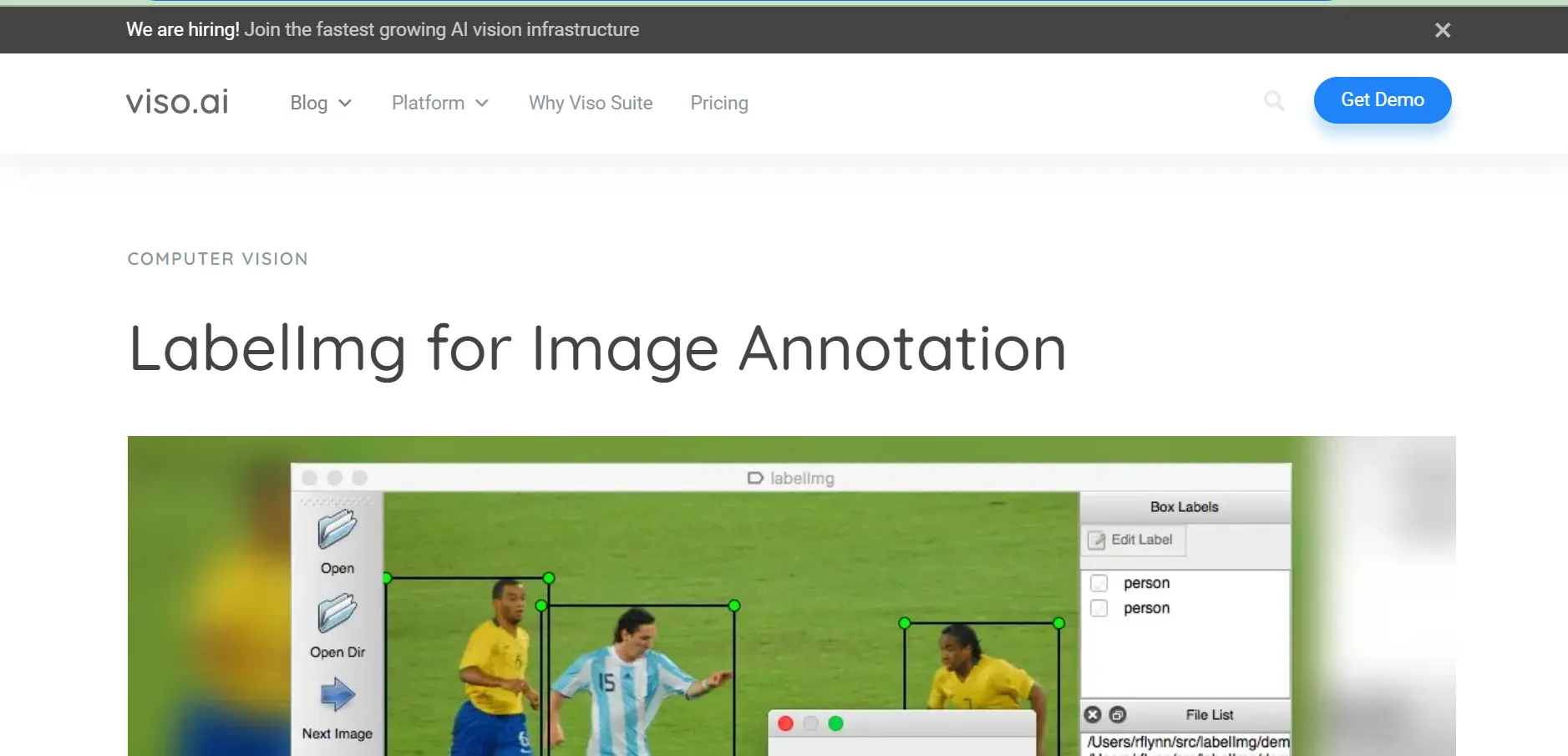
In the expansive universe of AI annotation tools, Labelimg shines like a star that’s both bright and reliable. It’s a tool that brings simplicity to the forefront, making the complex world of data annotation feel like a walk in the park.
If you’ve ever been daunted by the task of labeling images, Labelimg is the friendly guide you’ve been seeking. So, what makes Labelimg stand out? At its core, it’s the tool’s user-centric design.
Think back to those user-friendly apps on your phone that you love to use daily. No complications, just straightforward functionality.
Labelimg brings that same vibe to the table. It’s like having a conversation with a buddy who understands exactly what you need. With Labelimg, there’s no tech overload, just a clean, easy-to-navigate interface.
But don’t let its simplicity give you the wrong idea. Beneath its accessible exterior, Labelimg packs a punch. In the competitive arena of AI annotation tools, being accurate is non-negotiable and Labelimg delivers on that front.
It’s like having a detail-oriented friend who never misses a thing. You provide the images, and Labelimg ensures every aspect is perfectly labeled.
Collaboration is strength of Labelimg. In our interconnected world, working together is often the key to success. Labelimg champions this collaborative spirit.
It’s like a shared workspace where everyone can contribute, discuss, and refine. Whether you’re working solo or with a team, Labelimg ensures the process is smooth and inclusive.
One of the standout features of Labelimg in the world of AI annotation tools is its adaptability. The tech world is ever-evolving, and tools need to be agile.
Labelimg is like a dancer, graceful and adaptable, always in tune with the rhythm of the tech world. It evolves, adapts, and ensures you’re equipped with the best features at all times.
11. VoTT
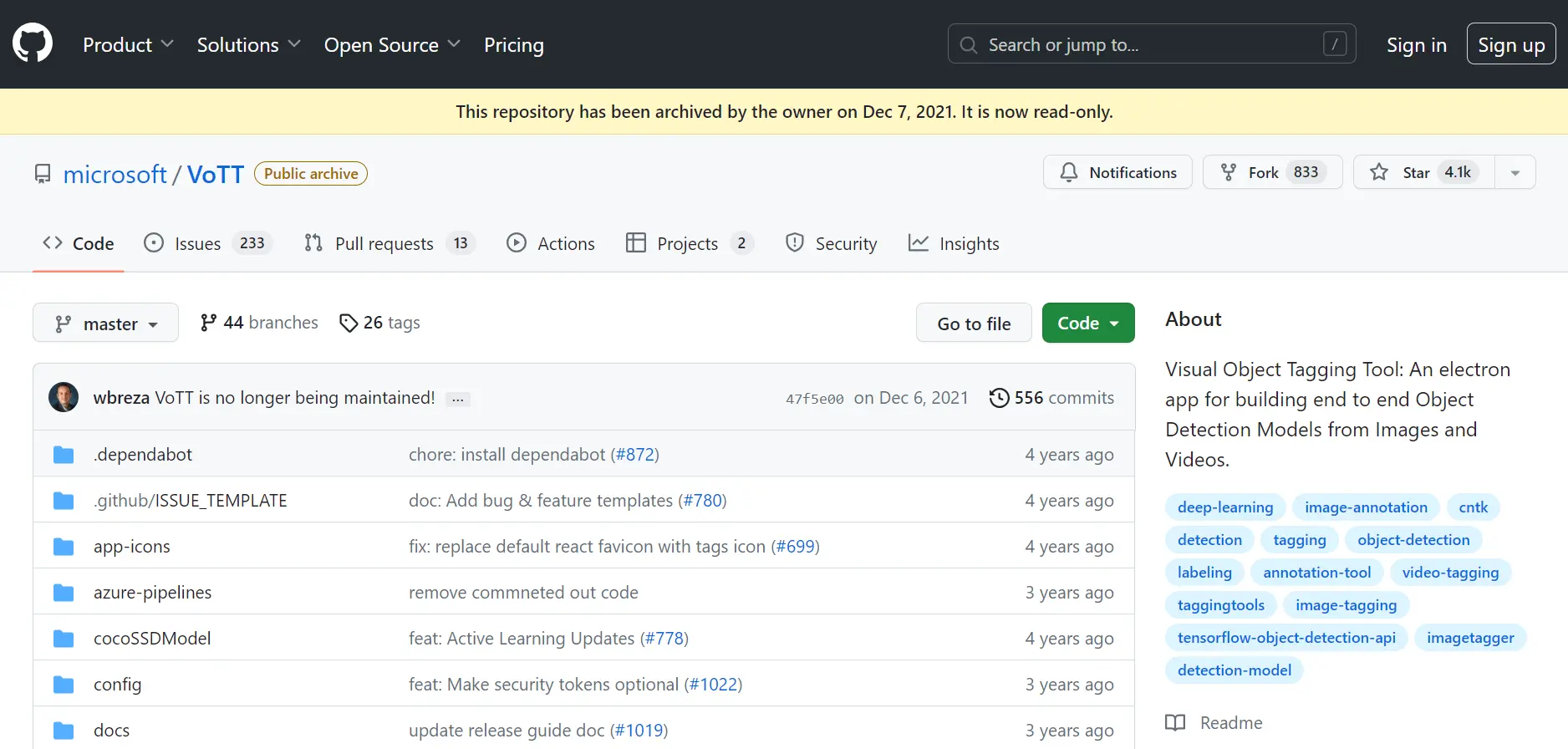
In the vibrant tapestry of AI annotation tools, VoTT (Visual Object Tagging Tool) emerges as a distinct and powerful thread.
It’s a tool that seamlessly blends functionality with user experience, making the intricate task of tagging visual objects feel like a delightful activity. If you’ve ever sought a tool that offers precision without complexity, VoTT is your answer.
So, what sets VoTT apart? First and foremost, it’s the tool’s dedication to visual clarity. Remember those clear, crisp photos that capture every detail? VoTT brings that clarity to the world of data annotation.
It’s like having a high-definition lens that zooms in on every essential aspect, ensuring nothing goes unnoticed. With VoTT, you’re not just tagging; you’re creating a visual masterpiece.
But VoTT isn’t just about clarity. At its heart, it’s a tool designed for the modern user. In the realm of AI annotation tools, being intuitive is crucial and VoTT nails it. It’s like that favorite app on your phone – easy to navigate, simple to use, and always reliable.
With VoTT, there’s no steep learning curve; it’s all about getting straight to the task with efficiency. Collaboration is another area where VoTT shines. In today’s interconnected era, pooling resources and insights often lead to better outcomes.
VoTT is like a collaborative canvas where multiple artists come together, each adding their unique touch. Whether you’re working with a small group or a large team, VoTT ensures everyone’s contribution is valued and integrated.
One feature that truly distinguishes VoTT in the crowded market of AI annotation tools is its flexibility. In a rapidly evolving tech landscape, adaptability is key.
VoTT is like water, taking the shape of its container, always ready to meet the user’s specific needs. It’s not rigid; it’s dynamic, ensuring you always have the right tools for the task at hand.
Conclusion
In the vast digital landscape, AI annotation tools have emerged as indispensable allies for businesses, researchers, and tech enthusiasts alike.
These tools, each with its unique features and strengths, are the unsung heroes behind the rapid advancements we witness in AI and machine learning.
From the precision of Labelimg to the collaborative spirit of VoTT, from the adaptability of Dataloop to the user-centric design of Supervisely, each tool brings something unique to the table.
They’re like the varied instruments in an orchestra, each playing its part to create a harmonious symphony. But why does this matter to you, the reader? Because in an age driven by data, understanding and utilizing these tools can be the difference between staying ahead or falling behind.
It’s not just about labeling data; it’s about harnessing the power of AI to drive innovation, solve real-world problems, and create a future that’s smarter and more efficient.
As we’ve journeyed through the world of AI annotation tools, one thing stands clear: the future of AI is not just about algorithms and codes.
It’s about tools that are user-friendly, collaborative, and adaptable. It’s about ensuring that the power of AI is accessible to everyone, regardless of their tech expertise.
In conclusion, as the world continues to evolve at a breakneck pace, tools like these will play an ever-increasing role in shaping our future. They’re not just AI annotation tools; they’re gateways to endless possibilities.
So, whether you’re a business owner, a researcher, or just a curious soul, dive into the world of AI annotation tools. Explore, learn, and be a part of the AI revolution.
Here are a few other hand-picked articles for you to read next:
- 20 Powerful AI Tools For UX Design You Must Know
- The Amazing Topaz Video Enhance AI’s Magical Touch: Enhance, Share, Enjoy
- 10 Best AI Image Creator Tools: Design Beyond Limits
- The Oxolo AI Video Generation Tool: Boost Your Sales
- Top 12 AI Video Enhancer: Enhance Video Quality To 4K
FAQs
What is an annotation tool in AI?
An annotation tool in AI is a software application designed to help label or tag data, making it understandable and usable for artificial intelligence models. These tools assist in converting raw data, like images, text, or videos, into structured data by adding relevant labels or tags. For instance, in image recognition, an annotation tool might be used to label objects within images, helping AI models learn and identify those objects in future datasets.
What are three tools used in annotation?
Three popular tools used in annotation are:
Labelbox: A versatile tool that supports image, video, and text annotations, widely adopted for its user-friendly interface and collaborative features.
VoTT (Visual Object Tagging Tool): Developed by Microsoft, it's a tool primarily for image and video annotations, offering integration with Azure Machine Learning.
SuperAnnotate: A platform that provides a comprehensive suite for image annotation, it's known for its speed and precision, making large-scale annotation projects more manageable.
What is an annotation tool in ML?
In machine learning (ML), an annotation tool serves the purpose of labeling or tagging raw data to train ML models effectively. This labeled data acts as the foundation upon which models learn and make predictions. For instance, if you're training a model to recognize cats in photos, you'd use an annotation tool to label or "annotate" cats in various images. Over time, with enough annotated data, the ML model can learn to identify cats in new, unseen images.
Why use annotation tools?
Annotation tools are pivotal for several reasons:
Efficiency: Manually labeling vast amounts of data can be time-consuming. Annotation tools streamline this process, making it faster and more organized.
Accuracy: These tools offer features like bounding boxes, polygons, and semantic segmentation, ensuring precise labeling.
Collaboration: Many tools provide collaborative features, allowing teams to work together, ensuring consistency in labeling.
Model Training: Properly annotated data is crucial for training robust AI and ML models. Without accurate labels, models can't learn effectively or make accurate predictions.
You May Also Like
10 Best AI face creator To Craft Faces with a Click
10 Best AI Image Creator Tools: Design Beyond Limits
10 Best AI music creator: The Future Sound of Music
10 must read Powerful Expert AI Content Marketing Tools: Ultimate Guide
10 Powerful and Best AI Tools for Developers: Expert Guide
10 Ultimate Trending AI Tools: Your Perfect AI Guide